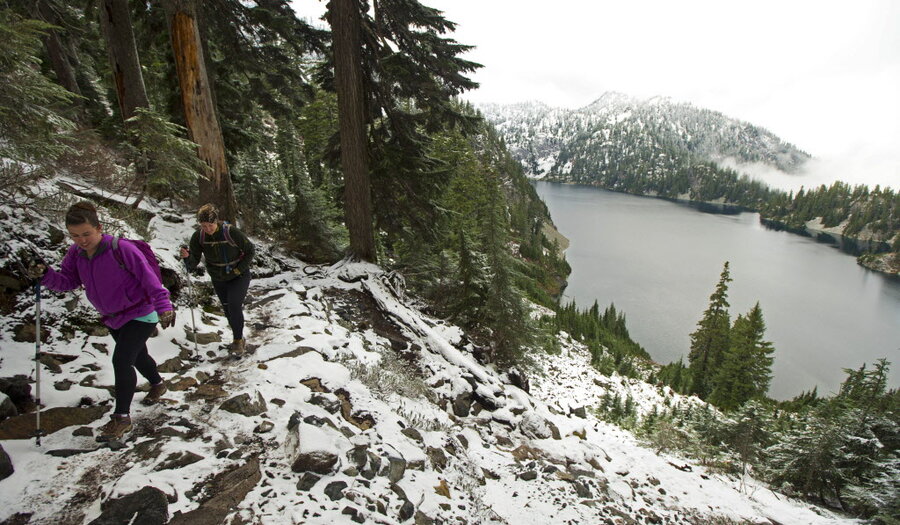Eleven necessities for budget hiking trips
Loading...
Spring has almost arrived, and for much of the country this means warm days for delightful countryside hikes. Whether a 1-mile ramble or a 10-mile trek, day hiking is even more pleasurable (or less likely to become unpleasurable) with a little preparation.
Take along the right equipment and supplies, and you'll be ready for any surprises, from inclement weather to map readers who turn your easy outing into something more daunting. Here's a checklist of supplies you might consider for your hike.
Proper Footwear
The right hiking shoe depends a great deal on the conditions you will encounter on your journey. For a short stroll on a pristine path, any comfortable shoes will do. However, if you plan to hike a long way on muddy, rocky, or steep paths, you'll want a good pair of boots that will keep your feet dry and support your ankles. These Hi-Tec Men's Logan Waterproof Hiking Boots ($51.73 with free shipping, low by $8) are waterproof, breathable, and provide the aforementioned ankle support.
Hiking Clothes
Consider wearing apparel made of a synthetic fiber or wool rather than cotton, which soaks up water like a sponge. (You wouldn't want to wind up a wet and cold hiker in danger of hypothermia.) You'll especially want socks that feature a wool blend to keep wet feet warm. These SmartWool Unisex PhD Nordic Ultra Light Crew Socks ($13.97 with free shipping, a low by $11) are made of a light wool and nylon blend, and have mesh for ventilation.
Remember to dress in layers while you hike, too, so you'll stay comfortable. A hat is great for both inclement weather and sun protection. And in addition to fabrics that handle moisture well, you can keep a poncho stuffed in your bag just in case an unexpected little April shower comes your way.
Pack
A daypack is a great way to carry all your supplies, and can be a useful bag to have around for other purposes. They can vary widely in terms of price, but since these are simple bags without too many bells and whistles, you don't need to break the bank for something sufficient. One of the most affordable packs we've seen lately is the sturdy, padded Oakley 15-Liter Snowmad Day Backpack ($34.95 with free shipping, $35 off list)
Map, Compass, or Backcountry GPS Unit
It's easy to become disoriented in the woods, so a standard trail map and compass are invaluable aids to keep track of where you are. An even better choice, albeit much pricier, is a GPS unit programmed with trails for the backcountry. Remember, your phone might not get service where you're going.
Binoculars
If you're headed out for a day-long hike in or around a nature preserve, it pays to pack a pair of binoculars. You'll be able to bird watch with ease or spot other wildlife from a distance. Check out our binoculars buying guide for more info.
Flashlight
A new LED flashlight will last much longer on a set of batteries than one with an incandescent bulb. A clip-on or headset will make night hikes even easier. This Ultrafire UK-68 Zooming LED Flashlight ($3.39 with free shipping, low by $1) has a beam range from 164 feet to 328 feet and a pocket clip.
First Aid Kit
A lightweight, general purpose first aid kit will keep you covered in case any nicks and cuts occur along the trailhead.
Knife & Fire Starter
It's useful to bring a few key tools with you on a hike because you never know what may happen. A knife is always a handy device to have — even better is a multi-tool, like this Samsonite Premium Travel Deluxe 12-in-1 Multitool ($9.99 with free shipping, low by $2).
Additionally, should you become stranded somewhere overnight, the ability to start a fire could be a lifesaver. If you take matches, keep them dry, but a lighter is a wise choice as well.
Food & Water
Energy bars and good old raisins and peanuts (GORP) make tasty trail snacks and are high-energy emergency provisions. Carry enough foodstuff to get you through to the next day in case of an emergency.
Also, pack plenty of bottled water, and, if appropriate, carry along a water filter. A neat trick from REI: Wrap your water bottle with several turns of duct tape, and you'll have the tape to use in an emergency.
Bug Repellent & Sunscreen
Nothing can destroy a pleasant ramble quicker than a hoard of mosquitoes or pesky black files. Your local outdoor store should be able to help find a repellent for the specific pests you're likely to encounter. And don't forget to wear sunscreen! Even under the canopy of a forest you'll be catching some sun rays, and your skin can burn sooner than you think. If you're an avid hiker consider investing in some bug-repellent clothing.
Emergency Blanket
You never know what might happen while hiking, so a simple emergency blanket is a smart item to keep on hand. It takes up very little space and weighs less than a pound, but can help keep you warm overnight in a pinch. If you bring along some string, you can turn this blanket it into a lean-to as well.
Why sit at home watching the boob tube when nature is inviting you to witness the annual miracle of spring? Just fill up that pack and head out to the trail; it will do both your soul and your soles good.
Tom Barlow is a freelance journalist specializing in lifestyle and consumer issues. This article first appeared at DealNews.







